From Mt Kenya to Samburu by Lucy
Samburu had become our goal while climbing Mt Kenya, thus we spent quite a lot of time building up our trip there – luscious swims in the river (not recommended by the doctors at home), leisurely game drives, fabulous wildlife etc. Happily, the game park was actually all that and more.
The drive there was pretty exciting – we had spent a night at a friend’s house at the bottom of Mt Kenya – we felt very pleased with ourselves sitting on his veranda eating breakfast, with Mt Kenya in the background, reminiscing that ‘this time yesterday we were on the top of that’, and taking photographs of the mountain in all its moods. This idyll was shattered when the rest of the party who hadn’t climbed the mountain (this time) arrived raucously and bundled us and the safari gear (some people have it ready packed in a safari box, much like an old school trunk!) into various automobiles, in order to set off for our Easter break.
The road to Samburu quickly became the track to Samburu, along which it’s necessary to drive at a certain speed, usually at least 50 mph, in order to start skipping over the corrugations and not be jolted quite as much. Even at this speed, I would recommend sports bras for the girls, definitely not bikinis.
Our big difficulty with driving as a convoy was the fact that every vehicle generates its own dust dervish, which surrounds the car and fills it with dust, which quickly melts into your inevitable sweat/suncream mixture, and does a much better job than fake tan. It meant stopping frequently and literally letting the dust settle in order to spot the rest of the convoy. You’d think that it would be fairly obvious that they’d be somewhere on the same road, but the problem is that roads in Kenya usually have 3 or 4 lanes at any one time – sometimes several hundreds yard apart – where some intrepid driver has decided they can map their own route much more effectively, and the rest follow. One of our highlights was a camel who decided to give us a race and galloped along beside us for quite a long time…I think we should have introduced it to Saudi Arabian camel racing, it’d give them a run for their money.
Anyhow, somehow we managed to arrive at the gate of the Northern Samburu game park and get in. The river was all but dried up, which although not great for us, was fantastic for finding wildlife as there was lots around the river. As we arrived at the rest time for the tourist game drives, we had the park pretty much to ourselves which was lovely. There were literally hundreds of Ele’s around, some really very little ones, and we watched their mothers dig holes in the dry river bed to get to the water below, and then show the babies how to get at it.
Seb, a complete safari guru, introduced us to the Grevy Zebra too – much less common than their cousins the Burchill’s Zebra, which are the sort that you normally see. Grevy’s have much narrower stripes (ever so much more slimming) and longer ears if I remember correctly. They are also much rarer and are mainly in the north of Kenya. Seb also introduced us to the famous ‘Ndege’ and ‘Sijui’ birds that he was very quick to name when asked. Guides usually know these well and will answer your eager ‘oh, quick, do you see that small bird with the colours on it, can you tell me what that is?’ with a solemn, ‘Ahhh, I believe that is one of the more rare varieties of Ndege bird.’ ‘Oh great’ you say, ‘I must look it up when I get back’, but you’ll never find them in any bird book.
It was only when we were listing off our sitings to some Swahili speaking Kenyans and saw their smirks as we told them about the ‘Ndege Bird’ and the ‘Sijui Bird’ that we found out that ‘Ndege’ means ‘bird’ in Swahili, and ‘Sijui’ means ‘I don’t know’!
To be fair, Seb is actually extremely knowledgeable about birds, and was able to spot birds from miles away and tell us what they were. I think that for more experienced Safari goers, they are much more challenging, as you pretty quickly learn to spot and identify an elephant.
We continued driving around a bit, and then realised the sun was setting. This happens very quickly in Kenya and so we tried to find a campsite. This took much longer than we’d thought, especially as random French people kept driving through our campsites.
The maddest thing about camping in game parks in Kenya is the fact that, when you are driving around, it is absolutely forbidden to get out of the car. However, when it comes to night time, you can get out and put up your tent, and sleep there! Mark and I, as you probably do, had thought that this would happen in carefully fenced and guarded enclosures. How wrong we were. Seb and Jo just leaned out the window looking at one spot, and said ‘ooh that looks like a good spot’. They did take a few things into consideration, like that it wasn’t on a shallow bank of the river (bad for being trampled by hippos) but otherwise it was just a nice open flatish space, conveniently located before the sun went down.
We unpacked and put up our tents, and were introduced to some of the locals, who came and showed us their pretty plastic jewellery and flowers. They seemed to live somewhere on the other side of the river and were quite interested in their neighbours, although when it was clear we weren’t going to be handing out cash, they didn’t linger.
One of the key things to consider when going on a safari I would recommend is ensuring that you have a keen and half decent cook with you. It makes the whole experience very much pleasanter. It means that having gathered some wood, one is then left alone to drink Gin or Tusker beer until dinner is ready, and only after this has taken place are you are expected to join in washing up. The happy thing about the washing up is that it is dark by then, and by the morning no one can identify the crockery that you have washed.
The drive there was pretty exciting – we had spent a night at a friend’s house at the bottom of Mt Kenya – we felt very pleased with ourselves sitting on his veranda eating breakfast, with Mt Kenya in the background, reminiscing that ‘this time yesterday we were on the top of that’, and taking photographs of the mountain in all its moods. This idyll was shattered when the rest of the party who hadn’t climbed the mountain (this time) arrived raucously and bundled us and the safari gear (some people have it ready packed in a safari box, much like an old school trunk!) into various automobiles, in order to set off for our Easter break.
The road to Samburu quickly became the track to Samburu, along which it’s necessary to drive at a certain speed, usually at least 50 mph, in order to start skipping over the corrugations and not be jolted quite as much. Even at this speed, I would recommend sports bras for the girls, definitely not bikinis.
Our big difficulty with driving as a convoy was the fact that every vehicle generates its own dust dervish, which surrounds the car and fills it with dust, which quickly melts into your inevitable sweat/suncream mixture, and does a much better job than fake tan. It meant stopping frequently and literally letting the dust settle in order to spot the rest of the convoy. You’d think that it would be fairly obvious that they’d be somewhere on the same road, but the problem is that roads in Kenya usually have 3 or 4 lanes at any one time – sometimes several hundreds yard apart – where some intrepid driver has decided they can map their own route much more effectively, and the rest follow. One of our highlights was a camel who decided to give us a race and galloped along beside us for quite a long time…I think we should have introduced it to Saudi Arabian camel racing, it’d give them a run for their money.
Anyhow, somehow we managed to arrive at the gate of the Northern Samburu game park and get in. The river was all but dried up, which although not great for us, was fantastic for finding wildlife as there was lots around the river. As we arrived at the rest time for the tourist game drives, we had the park pretty much to ourselves which was lovely. There were literally hundreds of Ele’s around, some really very little ones, and we watched their mothers dig holes in the dry river bed to get to the water below, and then show the babies how to get at it.
Seb, a complete safari guru, introduced us to the Grevy Zebra too – much less common than their cousins the Burchill’s Zebra, which are the sort that you normally see. Grevy’s have much narrower stripes (ever so much more slimming) and longer ears if I remember correctly. They are also much rarer and are mainly in the north of Kenya. Seb also introduced us to the famous ‘Ndege’ and ‘Sijui’ birds that he was very quick to name when asked. Guides usually know these well and will answer your eager ‘oh, quick, do you see that small bird with the colours on it, can you tell me what that is?’ with a solemn, ‘Ahhh, I believe that is one of the more rare varieties of Ndege bird.’ ‘Oh great’ you say, ‘I must look it up when I get back’, but you’ll never find them in any bird book.
It was only when we were listing off our sitings to some Swahili speaking Kenyans and saw their smirks as we told them about the ‘Ndege Bird’ and the ‘Sijui Bird’ that we found out that ‘Ndege’ means ‘bird’ in Swahili, and ‘Sijui’ means ‘I don’t know’!
To be fair, Seb is actually extremely knowledgeable about birds, and was able to spot birds from miles away and tell us what they were. I think that for more experienced Safari goers, they are much more challenging, as you pretty quickly learn to spot and identify an elephant.
We continued driving around a bit, and then realised the sun was setting. This happens very quickly in Kenya and so we tried to find a campsite. This took much longer than we’d thought, especially as random French people kept driving through our campsites.
The maddest thing about camping in game parks in Kenya is the fact that, when you are driving around, it is absolutely forbidden to get out of the car. However, when it comes to night time, you can get out and put up your tent, and sleep there! Mark and I, as you probably do, had thought that this would happen in carefully fenced and guarded enclosures. How wrong we were. Seb and Jo just leaned out the window looking at one spot, and said ‘ooh that looks like a good spot’. They did take a few things into consideration, like that it wasn’t on a shallow bank of the river (bad for being trampled by hippos) but otherwise it was just a nice open flatish space, conveniently located before the sun went down.
We unpacked and put up our tents, and were introduced to some of the locals, who came and showed us their pretty plastic jewellery and flowers. They seemed to live somewhere on the other side of the river and were quite interested in their neighbours, although when it was clear we weren’t going to be handing out cash, they didn’t linger.
One of the key things to consider when going on a safari I would recommend is ensuring that you have a keen and half decent cook with you. It makes the whole experience very much pleasanter. It means that having gathered some wood, one is then left alone to drink Gin or Tusker beer until dinner is ready, and only after this has taken place are you are expected to join in washing up. The happy thing about the washing up is that it is dark by then, and by the morning no one can identify the crockery that you have washed.
Some are cooks
Others are admirers
This made for a jolly evening as we sat around under the stars putting the world to rights over quite a number of bottles of Tusker beer (highly recommended). We retired to bed quite cheerfully as by then we were seasoned safari campers, with two nights in the Masai Mara under our belts already and Mark had his ear plugs to keep him happy.
The baboon clans of the locality had other things in store for us than sweet dreams sadly, though. The first thing we heard was a sound like a pack of dogs hot on the scent of some especially slow cats. Baboons bark like dogs, and they started this about midnight. The rival clan unfortunately seemed to be based just on the other side of the original group, and so they commenced barking at each other for the rest of the night. It seemed as though any minute they might think to themselves ‘Right, that’s enough of our bark, how about some bite!’ and charge into a pitched battle on top of our (rather small) tents.
Happily this didn’t happen, but in the morning Mark and I were flabbergasted to find that all we got from the seasoned safariers in reply to our sleepy complaints about the midnight barking was ‘What Baboons?’. Having photographed these creatures assiduously the previous day, our only reply to someone pointing out another specimen henceforth was ‘F*&%£$”$%ing Baboons’.
The baboon clans of the locality had other things in store for us than sweet dreams sadly, though. The first thing we heard was a sound like a pack of dogs hot on the scent of some especially slow cats. Baboons bark like dogs, and they started this about midnight. The rival clan unfortunately seemed to be based just on the other side of the original group, and so they commenced barking at each other for the rest of the night. It seemed as though any minute they might think to themselves ‘Right, that’s enough of our bark, how about some bite!’ and charge into a pitched battle on top of our (rather small) tents.
Happily this didn’t happen, but in the morning Mark and I were flabbergasted to find that all we got from the seasoned safariers in reply to our sleepy complaints about the midnight barking was ‘What Baboons?’. Having photographed these creatures assiduously the previous day, our only reply to someone pointing out another specimen henceforth was ‘F*&%£$”$%ing Baboons’.

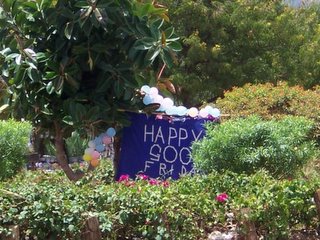
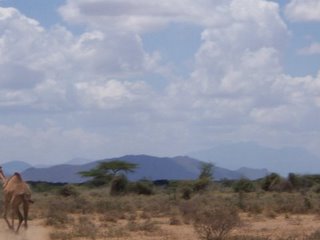

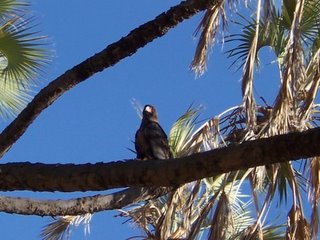
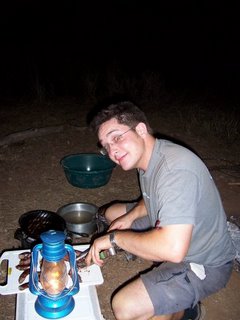
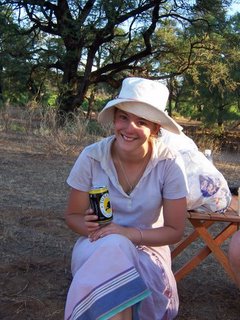





0 Comments:
Post a Comment
<< Home